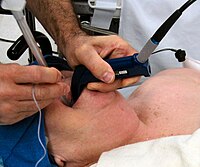
Photo from wikipedia
OBJECTIVE To evaluate whether pulse pressure variation (PPV) and pleth variability index (PVI) are more accurate than central venous pressure (CVP) for predicting fluid responsiveness in mechanically ventilated isoflurane-anesthetized dogs… Click to show full abstract
OBJECTIVE To evaluate whether pulse pressure variation (PPV) and pleth variability index (PVI) are more accurate than central venous pressure (CVP) for predicting fluid responsiveness in mechanically ventilated isoflurane-anesthetized dogs after premedication with acepromazine. DESIGN Prospective experimental trial. SETTING University teaching hospital. ANIMALS Twelve Harrier hound dogs. INTERVENTIONS Each dog was anesthetized and had a fluid challenge performed. This was repeated 4 weeks later for a total of 24 fluid challenges. After premedication with intramuscular acepromazine, anesthesia was induced with propofol and maintained with isoflurane. The dogs were mechanically ventilated with constant settings. The fluid challenge consisted of 10 mL/kg of 6% hydroxyethyl starch intravenously over 13 minutes. MEASUREMENTS AND MAIN RESULTS Before and after the fluid challenge, PPV, PVI, CVP, and other hemodynamics were recorded. Change in velocity time integral of pulmonary arterial blood flow by echocardiography was calculated as an indication of change in stroke volume. A fluid responder was defined as an increase in velocity time integral ≥ 15%. Receiver operator characteristic (ROC) curves were used to determine cutoff values. Areas under ROC curve were calculated and compared. Dogs responded on 14 fluid challenges and did not on 10. Cutoff values for PPV and PVI were 11% (sensitivity 79%; specificity 80%) and 9.3% (sensitivity 86%; specificity 70%), respectively. The areas under the ROC curve of PPV [0.85, 95% confidence interval (CI): 0.70-1.00, P = 0.038] and PVI (0.84, 95% CI: 0.68-1.00, P = 0.043) were significantly higher than CVP (0.56, 95% CI: 0.32-0.81). CONCLUSIONS PPV and PVI predicted fluid responsiveness more accurately than CVP and may be useful to guide fluid administration in mechanically ventilated isoflurane-anesthetized dogs after premedication with acepromazine.
Journal Title: Journal of Veterinary Emergency and Critical Care
Year Published: 2018
Link to full text (if available)
Share on Social Media: Sign Up to like & get
recommendations!